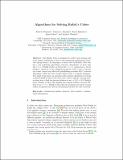Algorithms for solving rubik's cubes
Author(s)
Demaine, Erik D.; Demaine, Martin L.; Eisenstat, Sarah Charmian; Lubiw, Anna; Winslow, Andrew
DownloadDemaine-Algoritms for solving.pdf (212.0Kb)
OPEN_ACCESS_POLICY
Open Access Policy
Creative Commons Attribution-Noncommercial-Share Alike
Terms of use
Metadata
Show full item recordAbstract
The Rubik’s Cube is perhaps the world’s most famous and iconic puzzle, well-known to have a rich underlying mathematical structure (group theory). In this paper, we show that the Rubik’s Cube also has a rich underlying algorithmic structure. Specifically, we show that the n ×n ×n Rubik’s Cube, as well as the n ×n ×1 variant, has a “God’s Number” (diameter of the configuration space) of Θ(n [superscript 2]/logn). The upper bound comes from effectively parallelizing standard Θ(n [superscript 2]) solution algorithms, while the lower bound follows from a counting argument. The upper bound gives an asymptotically optimal algorithm for solving a general Rubik’s Cube in the worst case. Given a specific starting state, we show how to find the shortest solution in an n ×O(1) ×O(1) Rubik’s Cube. Finally, we show that finding this optimal solution becomes NP-hard in an n ×n ×1 Rubik’s Cube when the positions and colors of some cubies are ignored (not used in determining whether the cube is solved).
Description
19th Annual European Symposium, Saarbrücken, Germany, September 5-9, 2011. Proceedings
Date issued
2011-08Department
Massachusetts Institute of Technology. Computer Science and Artificial Intelligence Laboratory; Massachusetts Institute of Technology. Department of Electrical Engineering and Computer ScienceJournal
Algorithms – ESA 2011
Publisher
Springer Berlin / Heidelberg
Citation
Demaine, Erik D. et al. “Algorithms for Solving Rubik’s Cubes.” Algorithms – ESA 2011. Ed. Camil Demetrescu & Magnús M. Halldórsson. LNCS Vol. 6942. Berlin, Heidelberg: Springer Berlin Heidelberg, 2011. 689–700.
Version: Author's final manuscript
ISBN
978-3-642-23718-8
ISSN
0302-9743
1611-3349